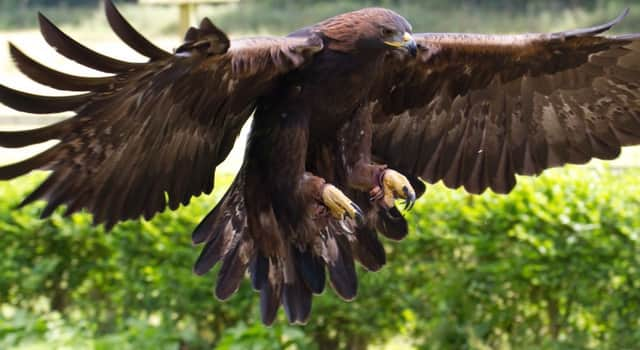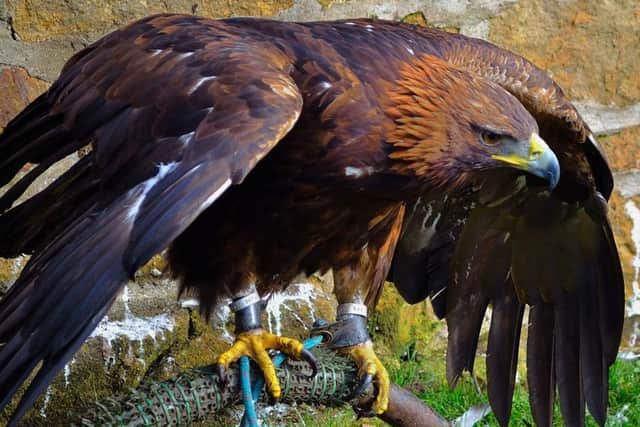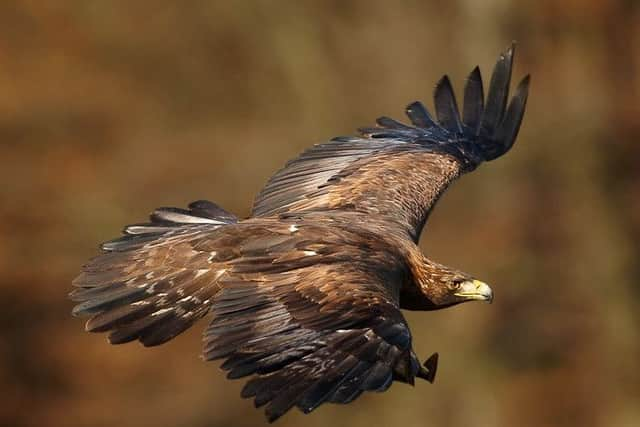10 interesting facts about Scotland's golden eagles


The golden eagle has always been fairly synonymous with the imagery of Scotland’s wildlife; the majestic bird of prey sits alongside the stag and the wildcat in the country’s pantheon of exalted yet elusive creatures. Should you be lucky enough to spot one, it can often be a memory that will last a lifetime.
Here are ten interesting facts you might not know about this most fascinating of birds.
Advertisement
Hide AdAll of the UK’s breeding pairs of golden eagles are found in Scotland


A pair had been breeding in the Lake District in 1969, but this nest, despite being reasonably successful until recent years, the disappearance of the female in 2004 left the continued presence of golden eagles in the Lake District in jeopardy.
Results from last year’s fourth golden eagle survey are yet to be released but the previous survey in 2003 recorded just 442 breeding pairs
Each pair has a nest is called an eyrie and these can be used for many years. Eggs are laid between early March and mid April. Incubation lasts 41 – 45 days so that the chicks hatch in late April to early June. The chicks then spend about 70 days in the nest before fledging from July to mid September. Some pairs can raise two young but most only raise one. They typically live to between 15 and 20 years.
The best places to spot a golden eagle are Mull and the Western Isles


The habitat on the west coast of Scotland is most suited to the eagles with plenty of food and ideal nesting sites.
Advertisement
Hide AdThe Golden eagle is not the largest bird of prey in the UK, that title goes to the white-tailed eagle
Though they have a huge 2m wing span, the golden eagle is slightly smaller than the white-tailed eagle which shares a similar shape and physiology to the golden eagle. It also enjoys similar habitats with 37-44 pairs taking up residence on Scotland western isles.
Advertisement
Hide AdThe white-tailed eagle was declared extinct in the UK during the early part of the 20th century - mainly due to illegal killing - and so the present population has been reintroduced to Scotland.


They are opportunistic feeders
The diet of a typical golden eagle is varied and includes hares, rabbits, ptarmigan, grouse, deer calves, and those living close to the coast have been known to eat seabirds and gulls. The scarcity of live prey means that the majority of their diet now comes from scavenging carrion, especially in the winter months.
Golden eagles are highly territorial
They have hunting and nesting areas that belong only to them or their mate, called ‘home ranges’.


Golden eagles have never carried off a toddler
Despite a youtube hoax that went viral in 2012 (a video was posted showing a toddler being carried off by an opportunistic eagle before being dropped as the terrified father looked on, later confirmed to be a hoax by a digital effects team in Canada) there haven’t been any reports, at least in modern times, of an eagle stealing a child.
Though the birds do possess a talon grip that’s up to 25 times more powerful than that of a human hand, and numerous tales from folklore (including a supposed Australian news report from 1904) that speak to the contrary, it has never been confirmed to have happened in Scotland. The birds are elusive and tend to avoid contact with humans wherever possible.
Golden eagles are monogamous and they pair for life
The eagles mate for life although if one of the pair dies, the survivors have been known to readily accept a new mate. They tend not to breed until they are at least four or five years old.
Advertisement
Hide AdThe golden eagle is afforded the highest degree of legal protection under the Schedule 1 of the Wildlife and Countryside Act 1981.
Thanks to the act it is considered an offence to intentionally take, injure or kill a golden eagle or to take, damage or destroy its nest, eggs or young. It is also an offence to intentionally or recklessly disturb the birds close to their nest during the breeding season.
The biggest threats to the golden eagle are us
Advertisement
Hide AdCurrent evidence indicates that illegal persecution and low food availability in parts of western Scotland are the two main constraints on the Scottish golden eagle population. In the 1950s and 1960s eagles suffered from pesticides which caused widespread infertility and eggshell thinning. The banning of these chemicals coupled with conservation measures, has seen the golden eagle population slowly recover in Scotland, although large tracts of its former range still lie unoccupied. The species was hunted to extinction in England, Ireland and Wales by around 1912.
DOWNLOAD THE SCOTSMAN APP ON ITUNES OR GOOGLE PLAY